Pharm Exec Ad Stars 2012
This year's Ad Stars embrace creativity through the eyes of the patients. Ben Comer and Jennifer Ringler report.
The campaigns chosen as Ad Stars this year include a diverse mix of clients, health conditions, and media channels. During the selection process, Pharm Exec perused awareness campaigns, direct-to-consumer and professional marketing, iPad applications designed specifically for sales reps, and campaigns that help recruit for clinical trials. Each of the campaigns were selected not only for their strength in relation to a particular therapeutic area, which is crucial, but also because something different in the creative caught our eye; not an easy task given the number of ads we're able to more or less ignore each day.

Getty images: Tetra Images
For many of these campaigns, the diseases they target represent distinctly different patient audiences—from elderly folks who need next-gen flu vaccines, to women suffering from tough-to-discuss vaginal dryness, to isolating and frightening conditions such as depression and schizophrenia. It's not the whiz and bang alone that makes for good medical advertising; it's the underlying knowledge of a disease, and what it means to have one, that leads to successful communication .

Marketers, including this year's Stars, always attempt to cater to their target audience—be it gastroenterologists or dermatologists—but rote market research alone doesn't provide enough paint for the portrait. Patients and doctors aren't all alike, but individual sentiment often reflects a common problem; understanding those problems from the perspective of the audience members leads to creative that's more persuasive, because it's more informed.
This idea of incorporating the patient perspective—into not only ads but in the healthcare delivery system as a whole—is not a new one, but it's a healthy movement that's growing. Increasingly, how patients feel about and react to their own health conditions is becoming a vital part of their diagnosis and treatment. In fact, Columbia University now has a graduate program centered around this idea, which they're referring to as narrative medicine: "Narrative Medicine fortifies clinical practice with the narrative competence to recognize, absorb, metabolize, interpret, and be moved by the stories of illness," reads Columbia's Narrative Medicine program website. "Through narrative training, the program in Narrative Medicine helps doctors, nurses, social workers, and therapists to improve the effectiveness of care by developing the capacity for attention, reflection, representation, and affiliation with patients and colleagues."
It seems only natural, then, to see this holistic, dynamic mindset spread into marketing as well. As healthcare providers are "moved by the stories of illness," so, too, are we moved by the advertising that captures those stories. (Whiz and bang usually doesn't hurt, either.)
There is no cure for schizophrenia, a disease that makes patients feel as if their mind, their families, and their lives are fragmented—much as the man pictured in the Latuda "Fragments" campaign created by AbelsonTaylor. The campaign, aimed at psychiatrists, shows "Joe," a schizophrenia patient who is left fragmented by his disease.

"Schizophrenia is a devastating disease and can tear patients apart," says Melissa Bauer Smith, Account Supervisor from AbelsonTaylor. The ad aims to show that "with Latuda, although no cure, the patient may experience symptom improvement—enough so that he can potentially begin the process of reintegrating into his family and society." This idea of reintegration and of family comes through in the "after" image of the ad as well. It's important to note that Joe is not shown to be completely cured or whole again, but that he is noticeably improved, happier, and has his mother by his side.
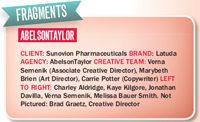
About 1 percent of the adult U.S. population is affected with schizophrenia, says Jonathan Davila, Associate Creative Director/Copy. "Profound symptoms such as scrambled thoughts, severe paranoia, and auditory and visual hallucinations leave patients frequently unable to lead independent lives" or to maintain effective relationships with friends and family. But with Latuda, Joe is able to feel more like himself again, and his relationship with his mother here is strong. "Family members and caregivers play a crucial role in the treatment process," he explains.

The creative process, according to AbelsonTaylor, was aiming for five qualities: "relevant, distinctive, quick, emotional, and campaignable." The hundreds of initial ideas that are tossed around get narrowed down to just a few, and in this case, nine concepts were shown to the client, Sunovion Pharmaceuticals. Five of those nine were brought into initial testing. "From there we did three rounds of qualitative testing with U.S. psychiatrists and each time, 'Fragments' rose to the top," says Verna Semenik, Associate Creative Director/Art.
The Fragments campaign ran in psychiatry journals and also consisted of a professional website, convention exhibits, and interactive sales aids for pharma reps. And by all accounts, it's been a success: "According to follow-up market research, the image of Joe and his mother is highly recognizable, and psychiatrists have commented on its ability to portray the devastating nature of the illness," says Bauer. —JR
Abottle of wine shatters with explosive passion, and with it, some stigmas and misconceptions about chronic pancreatitis (CP) are destroyed as well. The striking imagery in the "Shattering Perceptions" awareness campaign from Palio gets its target audience—gastroenterologists—to look at a disease they think they know well in a new light.

Among gastroenterologist, says Tiffany Ryan, VP, account services at Palio, "there was a pretty prevailing myth based on their med school training and on their own experience that all CP patients were alcoholics. But our data showed that only one-third of CP diagnoses were actually linked to alcohol, and so the objective was to increase the diagnosis and treatment of CP by dispelling the common misperceptions that were serving as barriers" to proper diagnosis and care.
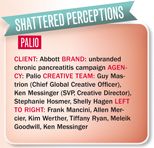
The image the creative team at Palio chose was intentionally dramatic. They could have gone with a glass of wine knocked on its side, perhaps, but the wow factor that draws the eye to the ad just would not have been the same. "We really wanted this to be dramatic, to get attention, and to dispel the myth," says Ken Messinger, Palio's SVP and creative director. "In fact, we had created a lot of different concepts that went into testing, but in the end it was the sheer stopping power of this image that was so critical to making sure the message was communicated."
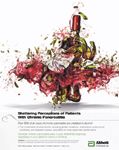
In addition to the expected creative team for such a campaign, Palio actually has two MDs on staff that that worked with them throughout the creative process, to help them "better understand the physician mindset," says Ryan. "Especially on a disease awareness campaign, I think that the cross-functional collaboration and understanding the science and clinical studies—as well as the current physician perceptions—is really key to generating a strong creative idea that can move the needle with physicians."
"Essentially, the goal is to shatter the misperception that most CP patients are alcoholics who did this to themselves," says Ryan.
And according to Messinger, it's working. "It's captured a lot of attention from physicians," he says. "Just hearing feedback anecdotally from sales reps, it seems like it's opening up physicians' eyes to the fact that what they've learned about CP patients all this time is not necessarily what's really happening." —JR
Concentric Pharmaceuticals had a challenging task when creating an ad campaign for LEO Pharmaceuticals' Taclonex, used to treat psoriasis. The campaign, aimed at dermatologists, needed to convey that Taclonex is unique—it's a topical that acts as a "combination" product, whereas most other treatments on the market are dual treatments that require alternating between a steroid and a vitamin D product. Because switching back and forth between the two traditional treatments, as most patients do, comes with a heap of side effects each time a patient goes on or off one of the two drugs, and because of the complexity of the treatment regimen, Taclonex has the potential to improve medication adherence by eliminating perceived barriers such as certain side effects and having to remember to switch on and off different medications.

But, according to Michael Sanzen, founder, co-CEO, and executive creative director at Concentric, the selling power of the dual-action treatment alone is just not enough. "Earlier campaigns had really focused heavily on the value of it being a combination," he says. "But what we learned over the years is that dermatologists are very, very conscious of their patients' level of satisfaction. Walking through the clinical story of the two-in-one wasn't really enough to convince them that this topical experience was going to be much better than their previous topical experiences."

With that in mind, the image of the woman unzipping her affected skin and expressing contentment at the clearer skin underneath was chosen. The words in the ad—strength and simplicity—were selected to represent the brand, and are reflective of the ad itself. One clear image and two straightforward words, rather than several lines of copy, project the message that simple is better. "We sort of stepped back and said, 'Let's just put on the page exactly what we're trying to get across here, that we can deliver this powerful clearance in one product, once a day,'" says Sanzen. "And we were surprised how well, in our opinion, that simple copy married with the image, even without pushing it to be conceptually linked. There's something about the elegance of that image that shows that combination of power and simplicity." —JR

The creative team at Praxis created a campaign to raise awareness of Venus Study, a clinical trial that was recruiting women suffering from vaginal dryness. Because the clinical trial is ongoing, the client (a pharma company) who commissioned the campaign is still hush-hush, but the campaign material is anything but—it aims to get people talking.

The campaign consisted of brochures and posters at clinical trial recruiting sites, letters for physicians to send to patients who might qualify as trial participants, and laminated pocket cards for doctors to keep with them. But the bold image of the nail polish bottles with not-so-subtle labels such as "love hurts" and "burn baby burn" is the true conversation-starter amongst women. "At some point in our lives we've all, as women, painted our nails," says Liz Maimone, senior copywriter. "And that's very important, because makeup and beauty are things that make a woman feel confident, and these women are feeling very vulnerable—they're not feeling very feminine."

To settle on just the right image that would evoke that sense of femininity and also familiarity among women who suffer from vaginal dryness, Praxis went above and beyond the traditional focus group approach. Maimone says, "We want to know: What are people talking about right now? Not what are they saying in a focus group, but what are they saying to their friends, and to other moms or other grandmas or other women?" So Praxis did its research by using search engines and typing in the same terms that patients suffering from the condition would type in, visiting blogs and chat rooms, and reading what the commentors on online news stories were saying. "People like to talk; you just have to be listening."

Due in large part to the creativity of the campaign and its ability to catch the target audience's attention, the client surpassed its goal of enrolling 690 women in the clinical trial, ending up with 722 instead, and was able, according to Tricia Barrett, Praxis' VP, operations, to "close things down a month early." And as she reminds us, "In the world of clinical research—where on average, it costs around $50,000 a day to conduct a clinical trial—being able to save time is the name of the game." —JR
Abilify picked up an indication as an "add-on" treatment for depression in 2007—the drug is also approved for bipolar disorder and schizophrenia—and that got Digitas Health thinking about what it means to be depressed. "Winston Churchill famously called depression his 'black dog,'" say Jacqueline Nolan and Graham Mills, co-executive creative directors at Digitas Health, in a co-authored email. "This intrigued us and so...we started asking people to do a drawing that described their depression." The result was a wide variety of visual metaphors: a ball and chain, a robe, a hole in the ground, and an umbrella that rains on the depressed person.

It would be difficult to film a umbrella raining on someone, and even harder to make the umbrella "alive," in the way that it is in the newest Abilify spots, which use animation to make the inanimate metaphors real characters; they stalk their victims. The campaign launched in the first quarter of 2011, and is ongoing, a testament to the ads' effectiveness. Animation is rare in pharma advertising; although Deutsch used animated spots a few years ago for the depression drug Zoloft, those Don Hertzfeldt-inspired spots were less compelling, and featured a blob-like humanoid, without a depression-personified character. The hand-drawn Abilify ads stand out through a combination of the story/characters, and the quality of the illustration/animation, created through a partnership with Th1ng, in London. Sylvain Chomet, producer of The Triplets of Belleville and The Illusionist, directed the TV spots.

But why are these animated spots so compelling? "Using animation makes it much easier for people to project themselves into the film," say Nolan and Mills. "There can be a downside to using real people...if they don't look like you, it's harder to identify with them." In other words, the single-line rendering of a cartoon character is an abstraction that lends itself to audience subjectivity. And then there's depression, that sad-eyed bathrobe with its agoraphobic implications. "We wanted to be able to show the daily struggle people have with their depression, however it's manifested," say Nolan and Mills. —BC
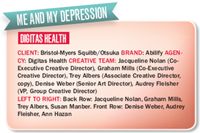
Chronic Obstructive Pulmonary Disease, or COPD, is one of the most common types of lung disease, and it's a serious burden for patients. Shortness of breath, and pain associated with deep breathing can give the impression of a heavy weight on the patient's chest, but that isn't the only downside. Smoking is a leading cause of COPD, and many patients are made to feel that they deserve the condition; blame often comes along with treatment.

Prior to DraftFCB Healthcare's Spiriva campaign, which features images of an elephant sitting variously on patients' chests, a different agency attempted to flip the Surgeon General's warning, associating treatment with positives, but patients still picked up the sense of guilt. However, the DraftFCB elephant campaign (which was shot using a real elephant—Rosie, who also starred in the 2011 film Water for Elephants) suggests that COPD is a separate entity, albeit a large one. This way, patients can think about improving their condition without any of the nagging blame associated with smoking.
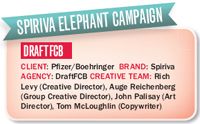
The elephant-on-your-chest theme carries into digital territories, including Spiriva.com, but DraftFCB Healthcare didn't create those assets. The agency does have the professional account, soon to be launched, but the creative is under wraps. In one television spot, the elephant in the room (COPD) first sits on a man's chest, then stalks him as he speaks to the camera and shoots billiards. By keeping the elephant in the frame as he lines up a shot on the table, DraftFCB wisely conveys the message that while Spiriva won't eradicate COPD, it can make it less of a burden. —BC
By now, the flu vaccine is a standard commodity in the eyes of most physicians. Handed a new flu vaccine intended specifically for the elderly —populations 65 years and older—Saatchi & Saatchi Healthcare Innovations were presented with the somewhat tricky task of convincing physicians that elderly patients need something different from the standard.

The image in the journal ads depicts a senior female peering into a mirror, and seeing her younger self: "Fluzone High-Dose vaccine – Because her immune system isn't 30 anymore..." reads the tagline. Also prominent is a message declaring that the vaccine is covered under Medicare Part B. "The visual helps bring to light the medical necessity for Fluzone High Dose within the 65-plus population, to help break through that idea that 'all flu shots are created equal,' and drive uptake for the brand," says the Saatchi creative team via email. The look that the female senior is giving to her gorgeous, 30-year-old self in the mirror seems to acknowledge the inevitable deterioration associated with age. But at the same time, there's a renewed confidence in the elder woman's profile; her arched eyebrows and half-smile insinuate a received confidence from younger form, and an acceptance of the aging process.

The campaign began last summer, and will run through 2012. Publicis Healthcare Communications has facilitated partnerships with Optimedia and Digitas Health, for digital and media executions. In addition to journal ads, the campaign also includes brochures and informational sheets to leave with physicians.

"The biggest challenge has been educating healthcare professionals on immunology in the elderly, and how it relates to influenza vaccination," says the Saatchi team. "We had to carefully balance the need for Fluzone High-Dose, within the 65-plus population, without creating distrust in the standard influenza vaccine, which could hurt overall immunization rates." —BC
The Misinformation Maze: Navigating Public Health in the Digital Age
March 11th 2025Jennifer Butler, chief commercial officer of Pleio, discusses misinformation's threat to public health, where patients are turning for trustworthy health information, the industry's pivot to peer-to-patient strategies to educate patients, and more.
Navigating Distrust: Pharma in the Age of Social Media
February 18th 2025Ian Baer, Founder and CEO of Sooth, discusses how the growing distrust in social media will impact industry marketing strategies and the relationships between pharmaceutical companies and the patients they aim to serve. He also explains dark social, how to combat misinformation, closing the trust gap, and more.
